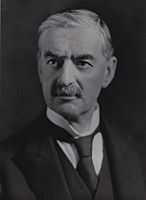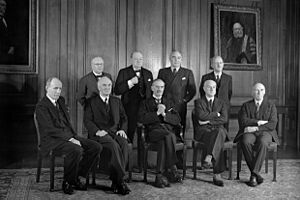Chamberlain war ministry facts for kids
Quick facts for kids Chamberlain war ministry |
|
|---|---|
| 1939–1940 | |
 |
|
| Date formed | 3 September 1939 |
| Date dissolved | 10 May 1940 |
| People and organisations | |
| Monarch | George VI |
| Prime Minister | Neville Chamberlain |
| Prime Minister's history | 1937–1940 |
| Total no. of members | 98 appointments |
| Member parties |
|
| Status in legislature | Majority (coalition)
428 / 615 (70%)
|
| Opposition party | Labour Party |
| Opposition leader | Clement Attlee |
| History | |
| Legislature term(s) | 37th UK Parliament |
| Outgoing formation | Norway Debate |
| Predecessor | Fourth National Government |
| Successor | Churchill war ministry |
The Chamberlain war ministry was the government of the United Kingdom led by Neville Chamberlain. It was formed in 1939 after Britain declared war on Germany, marking the start of World War II. This government guided the country through the first eight months of the war. However, after a key debate in Parliament about the war in Norway, Chamberlain resigned. Winston Churchill then took over and formed a new government.
Leading Britain in Wartime
How the Government Changed for War
On 3 September 1939, Neville Chamberlain, who was the Prime Minister of the United Kingdom, changed his existing government. He wanted to make it ready for the Second World War. A big change was bringing back Winston Churchill into the government. Churchill became the First Lord of the Admiralty, which meant he was in charge of the Royal Navy.
Other important changes happened too. Lord Caldecote became the Lord Chancellor, a top legal role. Sir John Anderson took over as Home Secretary, looking after internal affairs. Also, Anthony Eden returned to the government as the Secretary of State for Dominion Affairs, dealing with countries like Canada and Australia.
Who Was in the Government?
This government was mostly made up of members from the Conservative Party. They also had support from some National Labour and National Liberal politicians. However, it was not a "national unity" government. This means it did not include members from the main opposition parties, like the Labour Party or the Liberal Party.
The Small War Cabinet
A special feature of this government was its small War Cabinet. This was a small group of the most important ministers. They made the big decisions about the war. Most other government roles were not part of this small Cabinet.
The War Cabinet included:
- Prime Minister Chamberlain himself.
- Sir Samuel Hoare, who had a wide-ranging role.
- Sir John Simon, the Chancellor of the Exchequer, in charge of money.
- Lord Halifax, the Foreign Secretary.
- Winston Churchill, in charge of the Navy.
- Sir Kingsley Wood, the Secretary of State for Air, in charge of the Air Force.
- Lord Chatfield, the Minister for Coordination of Defence.
- Lord Hankey, a Minister without Portfolio, meaning he had no specific department but helped with general duties.
- Leslie Hore-Belisha, the Secretary of State for War.
Changes in the War Cabinet
In January 1940, Oliver Stanley took over from Leslie Hore-Belisha as the Secretary of State for War. In April 1940, Lord Chatfield left the War Cabinet, and his role was removed.
When the Government Ended
The Chamberlain war ministry came to an end on 10 May 1940. This happened when Prime Minister Chamberlain resigned. Winston Churchill then became the new Prime Minister and formed his own War Coalition government.
Key People in the Government
This section lists some of the important ministers in Chamberlain's government. Those who were part of the special War Cabinet are shown in bold.
War Cabinet Members (September 1939 – May 1940)
When the war started, Chamberlain completely reorganized the government. He created a small War Cabinet to make quick decisions.
- Neville Chamberlain – Prime Minister and Leader of the House of Commons
- Sir Samuel Hoare – Lord Privy Seal
- Sir John Simon – Chancellor of the Exchequer
- Lord Halifax – Secretary of State for Foreign Affairs
- Leslie Hore-Belisha – Secretary of State for War
- Sir Kingsley Wood – Secretary of State for Air
- Winston Churchill – First Lord of the Admiralty
- Lord Chatfield – Minister for Coordination of Defence
- Lord Hankey – Minister without Portfolio
Changes to the War Cabinet
- January 1940 – Oliver Stanley became the new Secretary of State for War, replacing Leslie Hore-Belisha.
- April 1940 – Sir Samuel Hoare and Sir Kingsley Wood swapped roles. Lord Chatfield left the government, and his position was removed.
Other Important Ministers (Not in the War Cabinet)
Many other important people worked in the government, even if they weren't in the small War Cabinet.
- Lord Caldecote – Lord Chancellor (Chief Judge and legal advisor)
- Lord Stanhope – Lord President of the Council (Managed government meetings)
- Sir John Anderson – Secretary of State for the Home Department (In charge of home affairs)
- Malcolm MacDonald – Secretary of State for the Colonies (Managed British colonies)
- Anthony Eden – Secretary of State for Dominion Affairs (Managed relations with self-governing parts of the British Empire)
- Lord Zetland – Secretary of State for India and Burma
- John Colville – Secretary of State for Scotland
- Oliver Stanley – President of the Board of Trade (Managed trade and industry)
- Lord De La Warr – President of the Board of Education (In charge of education)
- Sir Reginald Dorman-Smith – Minister of Agriculture
- Ernest Brown – Minister of Labour and National Service (Managed jobs and national service)
- Walter Elliot – Minister of Health
- Euan Wallace – Minister of Transport
- Leslie Burgin – Minister of Supply (Managed supplies for the war effort)
- William Shepherd Morrison – Minister of Food and Chancellor of the Duchy of Lancaster
- Herwald Ramsbotham – First Commissioner of Works (Managed public buildings)
- Lord Macmillan – Minister of Information (Managed public information)
- Sir Ronald Cross – Minister of Economic Warfare (Managed economic strategies during the war)
- Sir Walter Womersley – Minister of Pensions
- George Tryon – Postmaster General (In charge of postal services)
- Lord Winterton – Paymaster General
- Sir Donald Somervell – Attorney General (Chief legal advisor to the government)
- Sir Terence O'Connor – Solicitor General (Another legal advisor)
- David Margesson – Chief Whip (Managed party discipline in Parliament)
Changes to Other Ministers
- October 1939 – A new role, Minister of Shipping, was created. Sir John Gilmour was the first person to hold this job.
- November 1939 – Lord Winterton resigned as Paymaster General, and no one immediately replaced him.
- January 1940 – Oliver Stanley became the Secretary of State for War (and joined the War Cabinet). Andrew Duncan took over as President of the Board of Trade. Lord Macmillan resigned as Minister of Information, and Sir John Reith became the new minister.
- April 1940 – Robert Hudson took over as Minister of Shipping after Sir John Gilmour passed away. Lord De La Warr and Herwald Ramsbotham swapped their roles. William Shepherd Morrison and George Tryon also swapped roles, and Lord Woolton became the new Minister of Food.
- May 1940 – Sir Terence O'Connor died, and a new Solicitor General was not appointed before the government ended.


